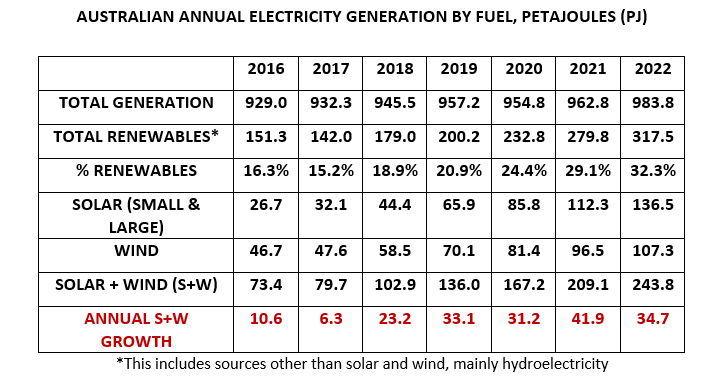Sound policy must be based on energy quantities. Many different measurement units are used in the energy field. The most common are based on joules and watt-hours or their multiples, like petajoules and gigawatt-hours. Some energy units have traditional connections with particular energy forms. And some users have their favourite units. It shouldn't matter; all energy units are interchangeable and online calculators now make it easy to get one consistent set of units.
There is a common trap with units. Those unfamiliar with energy may fail to distinguish properly between energy and power. Energy is to power as distance is to speed. Progress of an energy transition must be followed with energy quantities, as a journey is with distance.
Many of Australia's official energy statistics (e.g. Australian Energy Update) are expressed in petajoules. One petajoule (PJ) = 1015 joules. Petajoule accounting yields convenient numerical values for Australia's electricity generation. The table contains data for seven years. Final data for 2023 are not yet available but the general patterns indicate that the 2022 set is representative.
Advertisement

The second row, TOTAL RENEWABLES, shows the steady progress of the energy transition and rise in renewables, both quantity and percentage. The bottom row gives the annual numerical growth increments. Noone seems previously to have noticed that growth has levelled off in the last four years at an average around 35 PJ per annum.
Renewables advocates have for years liked talking about "exponential growth". It's not true and is obvious nonsense. Solar panels don't breed. They are not rabbits. "Exponential growth" is a reminder of how over-excitement produces wishful thinking.
Proper clean energy planning needs a firm goal, a clean energy quantity that enables total replacement and elimination of fossil fuels. That's the target. And if growth follows the current pattern then the time taken to reach that target is easily calculated. Unfortunately that target, the ultimate policy goal, is still hypothetical and will remain so until all future clean routes for replacing fossil fuels, and their clean electricity requirements, are fully established.
However there's a less rigorous way to reach a usable estimate. It relies on understanding the relative proportions of fossil fuel used for generating electricity and for all other purposes. Take the 2022 example. Australian Energy Statistics, Table F, Section 26, Electricity supply, Fuels consumed tells us that in 2022 coal, oil and gas to the amount of 2020 PJ were consumed in thermal generation (power stations) out of a total Australian consumption of 5250 PJ fossil fuel. 5250/2020 = 2.6. Now assume that had renewables output reached 983.8 PJ (total generation for 2022) then 2020 PJ fossil fuels would have been "saved", its need obviated. The next step is speculative; 2.6 X 983.8 PJ (2558 PJ) clean electricity would obviate all need for fossil fuel; 2558 PJ renewables would have been the ultimate clean electricity target for 2022.
This is not a rigorous deduction. It's an informed guess. It will have to do until something better turns up. But it dramatically influences how one interprets energy policy progress. With a 2558 PJ clean energy target the present conventional "100 percent renewables", 983.8 PJ, falls far short. We have seen it cannot conceivably mean elimination of fossil fuels. The notional 100% target is a sham.
Advertisement
And that's the core problem with present "percent renewables" policy targets. They exaggerate progress, they mislead, they fail completely to account for the clean electricity needed to displace fully Australia's fossil fuel consumption. And Australia swallows them.
This reasoning offers a starting point for setting a more rigorous renewables growth performance indicator. Let's call it "time-to-target". Assume, based on recent growth rates, that in the starting year 2023 the renewables total was 352 PJ. Then, from above, assume a final clean electricity goal to eliminate fossil fuels of 2558 PJ and a steady growth rate from solar and wind of 35 PJ per annum. Also assume for simplicity (as well as to discourage wishful thinking) that all other parameters like economic growth and energy productivity remain constant.
Then the gap today stands at 2558 PJ – 352 PJ = 2206 PJ and with growth at 35 PJ/year the goal would be reached in 63 years. 63 years! What a stark contrast with the incessant glowing publicity for renewables growth! Is the comparison fair? That might be debatable. But the simple fact is that "percent renewables" targets alone completely ignore the fossil fuels that industrialised economies do not use to generate electricity. That's the basic reason for the huge disparity between renewables sentiment and renewables reality.
Discuss in our Forums
See what other readers are saying about this article!
Click here to read & post comments.
14 posts so far.